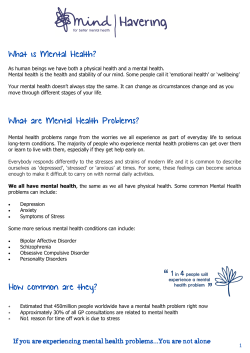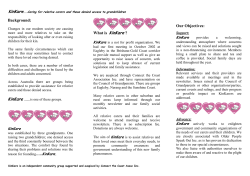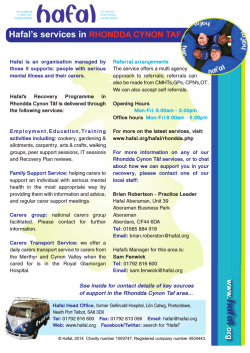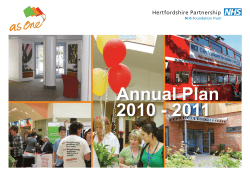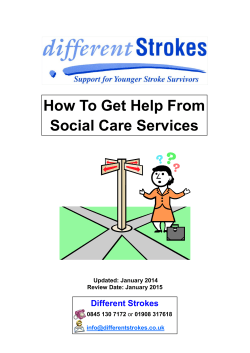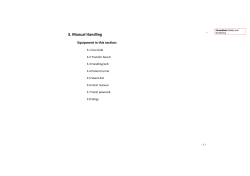
Family carers in palliative care: What is the best evidence...
Family carers in palliative care: What is the best evidence telling us? Key messages • Carers can have different views and experiences about being a carer and providing care [1-3]. For more: See CareSearch Perspectives on Family Carers • Some may not be aware that they are caring or do not wish to identify themselves as ‘carers’ [3]. For more: See CareSearch Carers • Families and carers are diverse. Ex-spouses, younger family members and siblings may all take on carer roles [4-6]. For More: See CareSearch Carers and Families • Geographical mobility of families in modern Australia means that family ties and social networks are stretched over distance. Little is known how distance influences caring and carer needs [7-8]. For More: See CareSearch Carers and Families • There are a wide range of carer needs and expectations reported in the literature, including: o To understand and have education around practical aspects of home-based care such as pain management, medications and symptom control [9-10] o To have patient symptoms effectively managed [11] o Appropriately timed information, delivered at the carer’s pace [12] o To have a wide range of issues explained – for example, how to cope with prognosis and retain hope [13] o To have practical, emotional, social, relational and spiritual support [14] o To have treatment and healthcare decisions respected [11]. For More: See CareSearch Supporting Carers • Support groups and supportive care (carer-specific counselling) appear to be beneficial to carers of people living with dementia, disability and mental illness [12] and of Motor Neurone Disease [13]. How this might transfer to other palliative populations is unknown. For More: See CareSearch Supporting Carers Active research areas and controversies in carer research • There is a lack of specificity and consensus in key definitions such as family carer, end-of-life or caregiver need [2-3]. Greater definitional clarity is needed. • More research is needed to understand issues around carer employment across the economy and how this impacts on those living with life-limiting illness [3, 17]. CareSearch is funded by the Australian Government Department of Health and Ageing. • There is wide agreement that more research on a finer and wider range of issues and outcome evaluations are needed in order to determine the efficacy of various interventions for the different types and ages of carers [13, 14, 18-20]. • More research is needed to clarify needs of family and carers who do not live nearby. More research is needed into the needs and issues regarding specific caring groups, such as Indigenous and CALD carers [1-2]. Caregiver gender also requires further investigation [3,21] . • The analysis of carer issues in paediatric palliative care may require particular attention given the complex and overlapping roles within the family [22-23]. • Little attention has been given to issues for patients who live alone and are their own carer [24]. REFERENCES 1. 2. 3. 4. 5. 6. 7. 8. 9. 10. 11. 12. 13. Australian Government Department of Health and Ageing (2011). Guidelines for a Palliative Approach for Aged Care in the Community Setting — Best practice guidelines for the Australian context, Australian Government Department of Health and Ageing, Canberra. Funk L, Stajduhar K, Toye C, Aoun S, Grande G, Todd C. Part 2: Home-based family caregiving at the end of life: a comprehensive review of published qualitative research (1998-2008). Palliat Med. 2010 Sep;24(6):594-607. Epub 2010 Jun 24. Stajduhar K, Funk L, Toye C, Grande G, Aoun S, Todd C. Part 1: Home-based family caregiving at the end of life: a comprehensive review of published quantitative research (1998-2008). Palliat Med. 2010 Sep;24(6):573-93. Epub 2010 Jun 18. Young carers NSW website http://www.youngcarersnsw.asn.au/ Lingler JH, Sherwood PR, Crighton MH, Song MK, Happ MB. Conceptual challenges in the study of caregiver-care recipient relationships. Nurs Res. 2008 Sep-Oct;57(5):367-72. Willyard J, Miller K, Shoemaker M, Addison P. Making sense of sibling responsibility for family caregiving. Qual Health Res. 2008 Dec;18(12):1673-86. McDonald P. Extended family in Australia: The family beyond the household, Fam Matters. 1992 Aug;32:4-9. Mature Market Institute. Miles away: The METLIFE study of long-distance caregiving, Westport, CT: Mature Market Institute; 2004. Bee PE, Barnes P, Luker KA. A systematic review of informal caregivers' needs in providing home-based end-of-life care to people with cancer. J Clin Nurs. 2009 May;18(10):1379-93. Epub 2009 Apr 8. Docherty A, Owens A, Asadi-Lari M, Petchey R, Williams J, Carter YH. Knowledge and information needs of informal caregivers in palliative care: a qualitative systematic review. Palliat Med. 2008 Mar;22(2):153-71. Kristjanson LJ. Issues in measuring family care needs and satisfaction. In: Portenoy R, Bruera E, editors. Issues in palliative care research. Oxford: Oxford University Press; 2003. Convey V, Ede J, Sealey T. How are the carers being cared for? A review of the literature. Eur J Palliat Care. 2008; 15(4):182-5. Clayton JM, Hancock K, Parker S, Butow PN, Walder S, Carrick S, et al. Sustaining hope when communicating with terminally ill patients and their families: a systematic review. Psychooncology. 2008 Jul;17(7):641-59. CareSearch is funded by the Australian Government Department of Health and Ageing. 14. Harding R, Higginson IJ. What is the best way to help caregivers in cancer and palliative care? A systematic literature review of interventions and their effectiveness. Palliat Med. 2003 Jan;17(1):63-74. 15. Eagar K, Owen A, Williams K, Westera A, Marosszeky N, England R, et al. Effective Caring: a synthesis of the international evidence on carer needs and interventions. Wollongong, NSW: Centre for Health Service Development, University of Wollongong; 2007. 16. Mockford C, Jenkinson C, Fitzpatrick R. A review: carers, MND and service provision. Amyotroph Lateral Scler. 2006 Sep;7(3):132-41. 17. Smith P, Payne S, Ramcharan P, Chapman A, Patterson M. Carers of the terminally ill and employment issues: a comprehensive literature review. Sheffield: Palliative and End-of-Life Research Group, University of Sheffield. 2006. No Abstract Available. 18. Mason A, Weatherly H, Spilsbury K, Aksey H, Golder S, Adamson J, et al. A systematic review of the effectiveness and cost-effectiveness of different models of community based respite care for frail older people and their carers. Health Technol Assess. 2007 Apr;11(15):1-157, iii. 19. Aoun S. The hardest thing we have ever done - The social impact of caring for terminally ill people in Australia, 2004. Deakin West, ACT: Palliative Care Australia; 2004. 20. Honea NJ, Brintnall R, Given B, Sherwood P, Colao DB, Somers SC, et al. Putting Evidence into Practice: nursing assessment and interventions to reduce family caregiver strain and burden. Clin J Oncol Nurs. 2008 Jun;12(3):507-16. 21. MacKinnon CJ. Applying feminist multicultural and social justice theory to diverse women who function as caregivers in end-of-life and palliative home care. Palliat Support Care. 2009 Dec;7(4):501-12. 22. Klassen A, Raina P, Reineking S, Dix D, Pritchard S, O’Donnell M. Developing a literature base to understand the caregiving experience of parents of children with cancer: a systematic review of factors related to parental health and well-being. Support Care Cancer. 2007 Jul;15(7):807-18. 23. Young B, Dixon-Woods M, Heney D. Identity and role in parenting a child with cancer. Pediatr Rehabil. 2002 OctDec;5(4):209-14 24. Aoun S, Kristjanson LJ, Oldham L, Currow D. A qualitative investigation of the palliative care needs of terminally ill people who live alone. Collegian. 2008;15(1):3-9
© Copyright 2025




